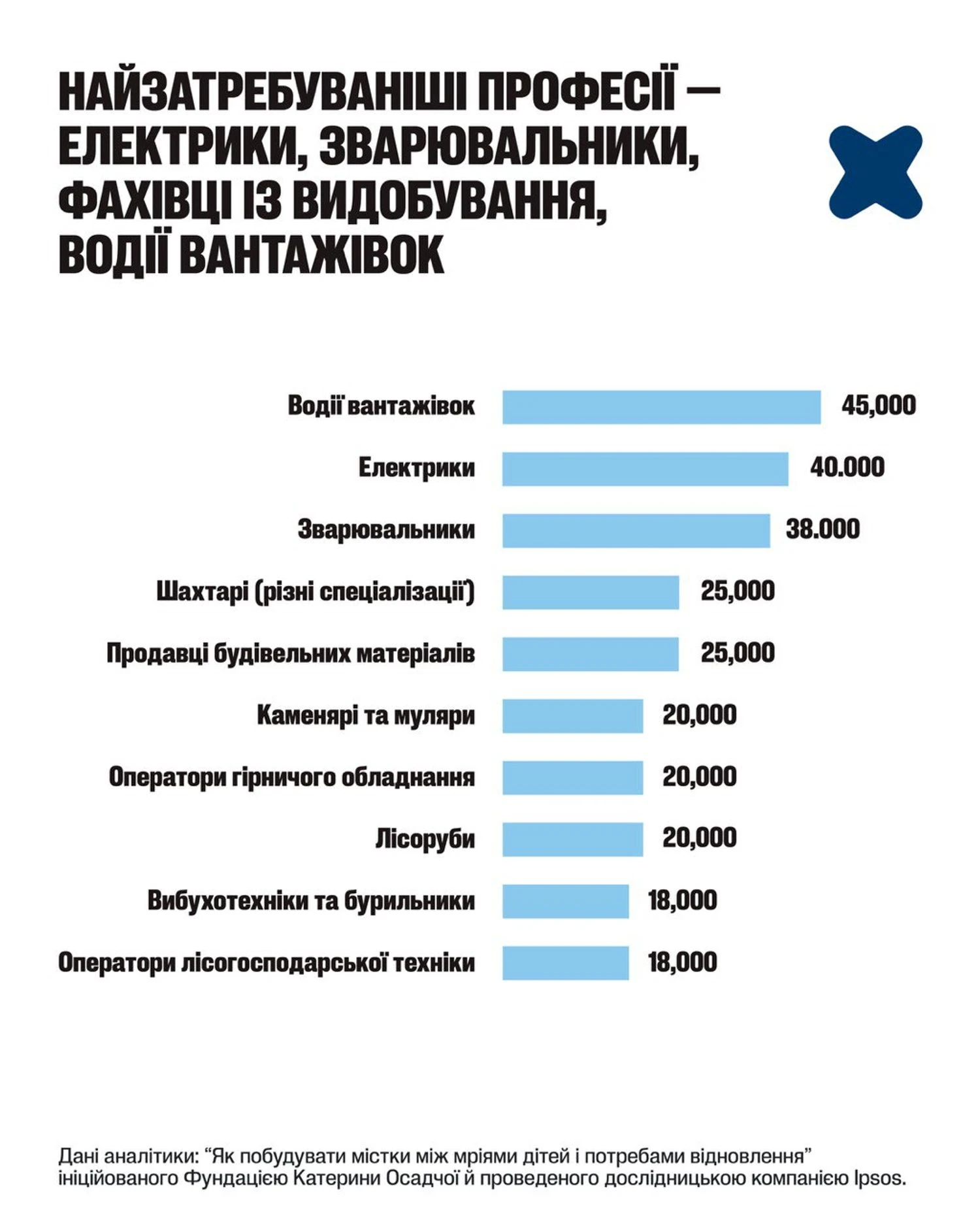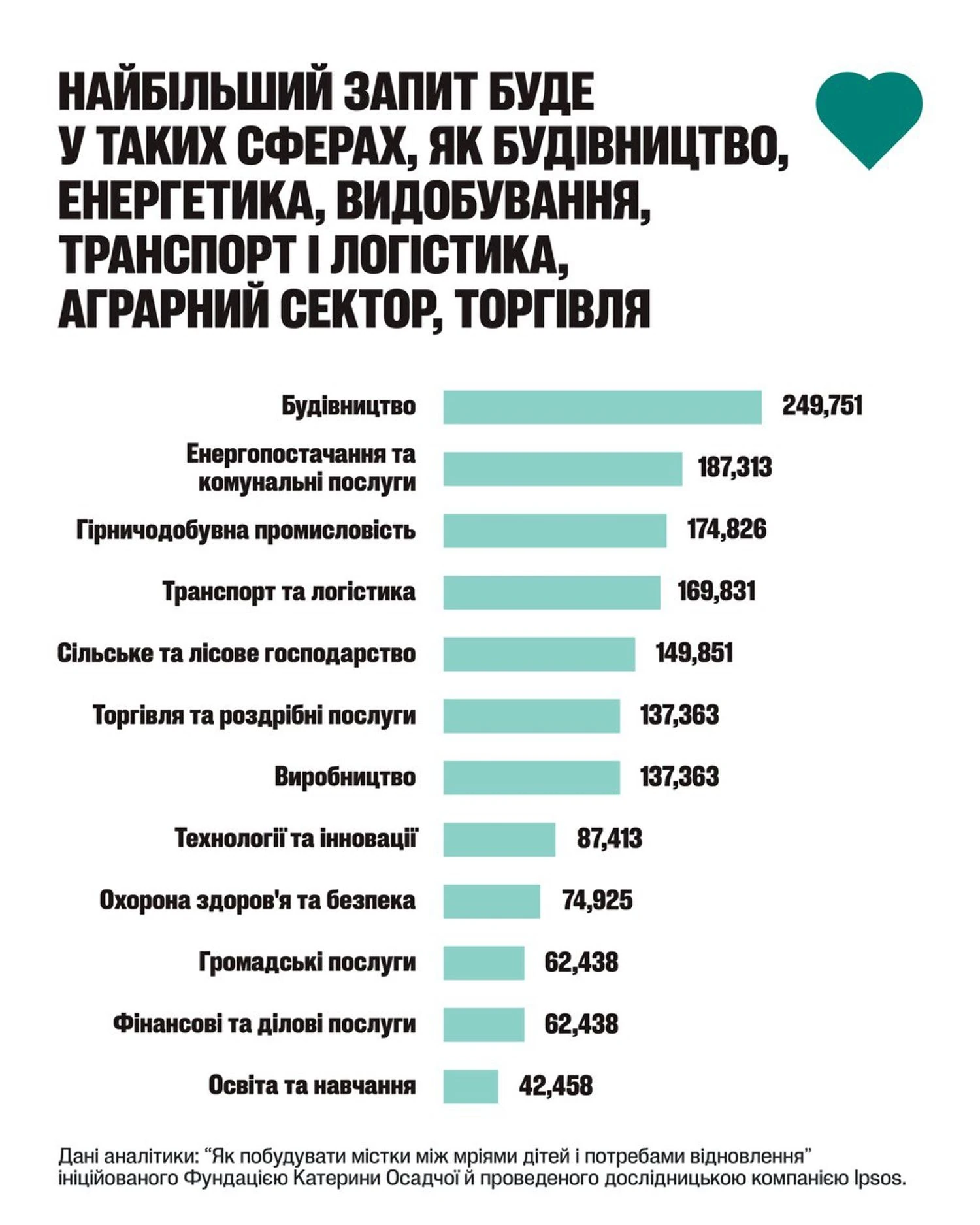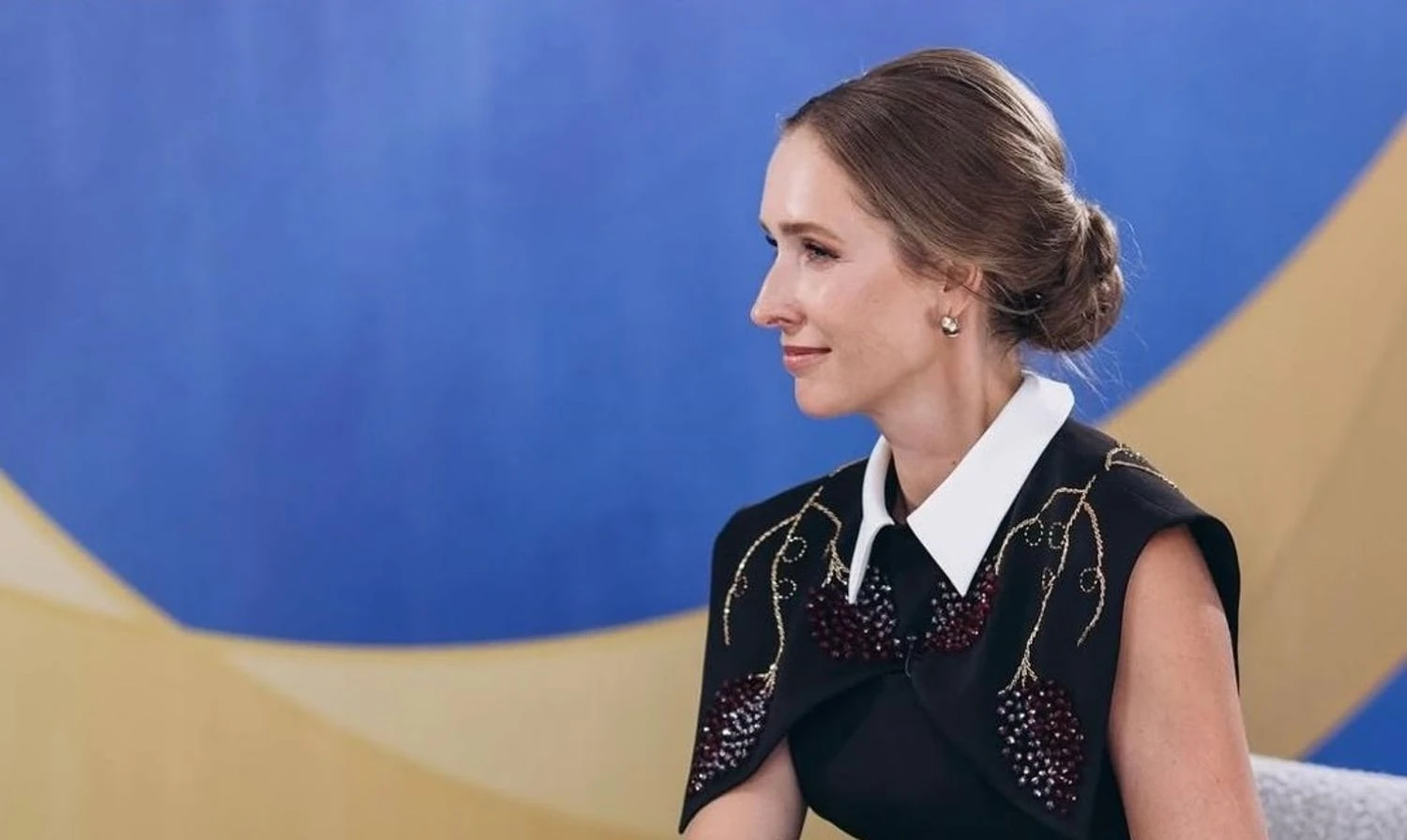“Children’s dreams and Ukraine’s reconstruction needs do not align: Kateryna Osadcha told how Ukrainian graduates choose future professionsAnalysis by Kateryna Osadcha’s Foundation and Ipsos revealed discrepancies between graduates’ dreams and the needs of Ukraine’s
labor market. The country needs 1.5 million new workers, primarily in blue-collar professions, for reconstruction.
”, — write: unn.ua
How teenagers choose professionsToday, according to Osadcha, teenagers often choose professions based on their trendiness, media presence, status, and sometimes the absence of physical labor. But this does not always correspond to the real needs of the market.
Analytical studies, including “Future Index” conducted by Olena Zelenska’s Foundation, show that 8 out of 10 teenagers think about their profession, but only 30% have decided what they want to be at 30 years old.
The orientations of young people, by which they choose a profession, are their own interests and the popularity of the profession in the media. Often, an additional factor is parental pressure or their experience. However, the romanticized image of a profession often does not correspond to reality. Because of this, young people may choose an irrelevant specialty, spend time studying, but not work in their field.
Admission campaign: the Ministry of Education and Science explained the conditions under which educational grants can be obtained29.07.25, 15:35 • 2266 views
Outdated ideas about professions also hinder. For example, the agricultural sector has long needed not only agricultural machinery drivers but also IT specialists, engineers, and chemists. At the same time, there is a shortage of applicants for chemistry faculties in Ukrainian universities, says the founder of the foundation. Despite the fact that chemists are also needed in pharmaceuticals, which is actively developing in Ukraine, Osadcha says.
In particular, graduates rarely choose blue-collar specialties, so there is a shortage of specialists in these areas as a result. Osadcha added that “sometimes the difference between the popularity of a profession among young people and the real demand in the market can be tenfold.” However, choosing a “blue-collar specialty” does not indicate a lack of long-term prospects.
The fact that you are, for example, an electrician today, does not mean that you will remain one for life. It is important to show the path of development. For example, a qualified electrician can later open his own business providing such services
Therefore, according to Osadcha, it is necessary to change the attitude towards blue-collar specialties. In the modern world, a technical specialty “can offer much more prospects than a ‘fashionable’ profession.”

How teenagers’ desires currently align with the demands of the Ukrainian labor market In most cases, the desires of Ukrainian teenagers regarding their future profession do not coincide with the needs of reconstruction. Gaps between supply and demand are particularly noticeable in certain areas.
Admission campaign: The Ministry of Education and Science named specialties with sufficiently low employment rates29.07.25, 14:50 • 2724 views
Ipsos analysts calculated how many specialists Ukraine will need for post-war recovery. To do this, they used data from the Damage and Needs Assessment (RDNA4) study and, using modeling, determined that the country will need about 1.5 million new workers.
They also identified which areas will have the greatest demand for personnel and compared these results with children’s ideas about future professions — based on the “Future Index” survey. This helped to understand whether the country’s needs coincide with what children want to become.
Ukrainian youth more often choose IT, design, healthcare, beauty, education, and law. At the same time, the processing industry will need about 20% of the total number of workers, but only 2% of teenagers expressed a desire to work in this field
According to her, a similar situation exists in the energy sector: the need is 12%, but only 1% are interested. It is necessary to convey relevant information about market needs to teenagers, to introduce them to various industries. After all, those who choose a profession today will only start working in 3-5 years. And there is a risk that the chosen profession will no longer be relevant by then.
“Therefore, it is very important to choose a profession taking into account future needs. If we spend three to five years on irrelevant education, we will lose valuable human capital,” the presenter emphasizes.
“We already have a shortage of personnel. And this problem is only getting worse. Therefore, we need to talk about it and look for solutions together,” she concluded.
During the study, a graph was created that clearly demonstrates the gaps between the desires of young people and real needs.

In the red zone are the biggest discrepancies between what children want and what the market needs. The gray zone represents industries where children’s plans exceed demand. For example, design or law are popular, but in the context of reconstruction, they are less in demand for project implementation. The green zone represents industries where there is some convergence: agribusiness, security.
What is the current demand in the labor marketOsadcha noted that the analytics are based on the understanding that the country’s reconstruction is not a matter of the future. It is already underway, parallel to the war. We are already restoring what was destroyed, and the need for personnel is relevant today.
According to Osadcha, there is currently a high demand for blue-collar specialties.
To develop our analytics, we collaborated with the State Employment Service, and their data show that in the first half of 2025, the largest number of vacancies were for service and service provision workers, specialists with special skills and knowledge (drivers, locksmiths, seamstresses, electricians), specialists with higher education (teachers, accountants, engineers, doctors), unskilled workers (loaders, cleaners, and auxiliary workers). Employers currently experience the greatest shortage among specialists with special skills and specialists with higher education
At the same time, according to her, applicants are currently choosing professions that do not always meet the needs of reconstruction. Especially in the context of higher education.
“We see data from the Ministry of Education and Science, which show that in this admission campaign, future students most often choose the specialties ‘Law’, ‘Management’, and ‘Philology’. Although the market is oversaturated with such specialists. On the other hand, the demand for ‘Psychology’, ‘Medicine’, ‘Engineering’ specialties has increased — and this is a good trend. Of course, the admission campaign is in full swing and the situation may change, but for now, these are the trends,” Osadcha explained.
However, among those who are obtaining a qualified worker degree, according to the analytics, the most popular specialties are cook, locksmith for repairing wheeled vehicles, tractor driver-machinist of agricultural production, hairdresser, and electric gas welder.
Adaptability – key to successAccording to global studies, modern people change professions 3-4 times during their lives due to rapid technological progress and the disappearance of a number of specialties. Ukrainians have already experienced these changes firsthand: due to the war, many people have changed their field of activity or place of work. This proved that adaptability has become a key skill. It is this skill that should be developed in children.
These are the needs of the modern world. And this is what the foundation is doing — helping young people to be flexible and adaptable, to choose a path that will help them realize their talents, and at the same time will be in demand in the market. Because it is the youth who will rebuild the country, make it prosperous
How parents can help a child choose a profession without pressureTo help a child decide on a future profession, it is important to start career guidance at an early age, says Osadcha. Various studies cite different ages for starting career guidance.
In elementary school, this can involve simple conversations about professions, discussing books, and observing different professions in everyday life. It is worth showing the child what parents do, and introducing them to the professions of friends and relatives.
At the age of 10-13, it is important to pay attention to the child’s interests, help them understand what makes their “eyes light up,” what they like, and what they don’t. Career guidance tests, practical classes, and demo days, when a teenager spends time at work with parents or relatives, can push the child towards a conscious choice.
Admission-2025: the number of applications this year increased by 4%26.07.25, 12:03 • 4123 views
After 14 years, teenagers already understand themselves better. Parents should give them practical tools: testing, internships, familiarization with real working conditions. It is worth encouraging visits to workplaces, participation in career guidance events. This helps to break down myths, for example, that design is purely one designer profession, and not a whole chain of specialists, Osadcha gives an example.
The key is not to pressure, but to support. Not to decide for the child, but to provide opportunities, resources, and space for self-discovery.
What the government is currently doing to make vocational education more prestigious
Currently, the launch of a professional excellence program is underway in cooperation with the EU, the EVSTUP initiative is working, and grants are also provided for training in critically important specialties.
Earlier, UNN wrote that more than a third of Ukrainian vocational and technical educational institutions submitted applications for participation in the state program for repairing educational premises and updating equipment.
Also, the first 72 vocational and technical educational institutions have been identified that will receive 500 million hryvnias of state funds for modernizing their workshops, among which the most demanded areas are agriculture, public catering, industry and mechanical engineering, construction, and road transport.
However, even with the modernization of educational institutions, young people often lack information about the content and prospects of these professions.
What is missing for quality career guidance for Ukrainian students and personnel trainingAccording to Iryna Baleva, director of Ipsos, the company that directly conducted the research in Ukraine on behalf of the Foundation, the steps taken so far are correct, but insufficient. She emphasizes that parents and families need to be involved in the career guidance process. Also, children, with the support of their parents, will be more willing to go into those areas where they see systemic support from the state – through programs, investments, scholarships, Baleva emphasizes.
In my opinion, says Iryna, it would be very useful to create “business incubators” at schools and educational institutions. She says that these could be spaces where students would be taught not only specific professions, but also the basics of entrepreneurship – with theoretical knowledge, practical skills, mentoring support, and access to equipment or workshops.

It’s about young people seeing concrete paths for themselves, so that they don’t find themselves in a “stormy sea” after graduation without support or guidance. Also, according to her, it would be good if preferential loans for young entrepreneurs or special programs stimulating their economic activity existed in parallel. There are already grants for young people from the Ministry of Economy, and this is a good example of stimulating youth entrepreneurship.
It is also necessary to strengthen interaction with business. In many industries, business can act as a training provider, an investor in the training of specialists.
“It is necessary to coordinate forms of communication with business, because a lot of professional training can be conducted by business and invested in education, because the state cannot solve everything,” says the director.
MES on Olympiad winners going abroad: this is a very significant percentage25.07.25, 15:50 • 3837 views
Another important area is social dialogue. We need to talk about labor standards, employment guarantees, clear signals from the state that certain industries will definitely develop.
“If business knows that, say, a large state program starts in 2027, it will start training personnel already in 2025 – forming logistics, training staff, building partnerships. All this is possible only under conditions of open and strategic dialogue between the state, business, and civil society,” Baleva concluded.
A separate problem, according to her, is time. According to Baleva, a system of so-called anticipatory learning is needed – intensive courses that shorten basic training with subsequent short upgrade programs. This approach usually works after crises – for example, for training engineers or technical specialists.
“This is a format where you can ‘package’ a four-year course into two. And, for example, some post-courses like qualification upgrades, for three months, for half a year. Usually, this is a more intensive daily training program, it may be that they study on Saturdays,” she explained.
According to Kateryna Osadcha, it is also important that career guidance becomes part of the recovery infrastructure.
“Reconstruction projects should have a component of specialist training. In addition, it is important that the career guidance systems that already exist are modern, interactive, and future-oriented,” says Kateryna.
According to her, teenagers’ interest in career guidance is currently quite low. The “Future Index” shows that only 17% of children took career guidance tests, 4% attended job fairs, and 7% communicated with career advisors. For most, the only career guidance is a conversation with parents (74%).
She also believes that for effective preparation of young people for the future labor market, the state, business, civil sector, international partners, schools, and parents must create an ecosystem of cooperation and support.
Career guidance should not only be the responsibility of parents or schools. It should correlate with labor market trend analytics, state investment priorities, and reconstruction plans. And for this, dialogue is needed


